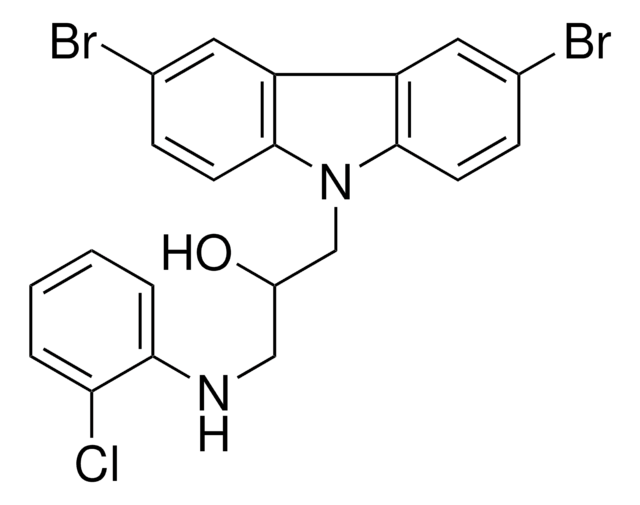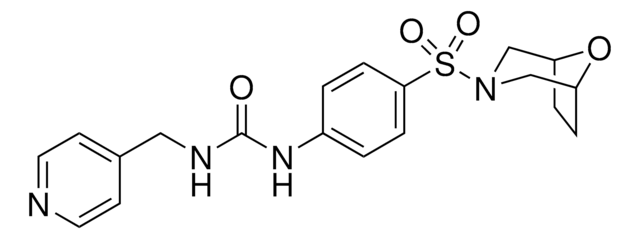所有图片(1)
About This Item
经验公式(希尔记法):
C21H18Br2N2O
CAS号:
分子量:
474.19
MDL號碼:
分類程式碼代碼:
12352203
PubChem物質ID:
NACRES:
NA.25
推荐产品
化驗
≥98% (HPLC)
形狀
powder
顏色
white to off-white
溶解度
DMSO: 34 mg/mL
儲存溫度
2-8°C
SMILES 字串
OC(CNc1ccccc1)Cn2c3ccc(Br)cc3c4cc(Br)ccc24
InChI
1S/C21H18Br2N2O/c22-14-6-8-20-18(10-14)19-11-15(23)7-9-21(19)25(20)13-17(26)12-24-16-4-2-1-3-5-16/h1-11,17,24,26H,12-13H2
InChI 密鑰
FZHHRERIIVOATI-UHFFFAOYSA-N
應用
P7C3 is an aminopropyl carbazole agent with proneurogenic and neuroprotective properties in newborn neural precursor cells of the dentate gyrus. Its analogs may be used in neurodegenerative disease research to study the process of neurogenesis in brain regions such as the subgranular zone of the hippocampal dentate gyrus. P7C3 and its analogs may be used to study its pharmacokinetics, metabolism, safety, efficacy and methods of delivery as potential drug for the treatment of condition such as Alzheimer′s disease, Parkinson′s disease, amyotrophic lateral sclerosis and traumatic brain injury.
生化/生理作用
P7C3 is neurogenic and protects new neurons against apoptosis. These activities may be related to its capacity to protect mitochondrial integrity.
Degeneration of the hippocampus is an early manifestation of Alzheimer′s disease. P7C3 promotes neurogenesis in the subgranular zone of the hippocampal dentate gyrus, the site of normal neurogenesis in adult mammals, making it an important lead compound in development of new Alzheimer′s treatments.
Degeneration of the hippocampus is an early manifestation of Alzheimer′s disease. P7C3 promotes neurogenesis in the subgranular zone of the hippocampal dentate gyrus, the site of normal neurogenesis in adult mammals, making it an important lead compound in development of new Alzheimer′s treatments.
訊號詞
Danger
危險聲明
危險分類
Acute Tox. 3 Oral - Eye Dam. 1
儲存類別代碼
6.1C - Combustible acute toxic Cat.3 / toxic compounds or compounds which causing chronic effects
水污染物質分類(WGK)
WGK 3
閃點(°F)
Not applicable
閃點(°C)
Not applicable
Hidehiro Oku et al.
Japanese journal of ophthalmology, 61(2), 195-203 (2016-12-30)
To determine whether P7C3-A20, a proneurogenic neuroprotective agent, can protect the retinal ganglion cells (RGCs) of rats from optic nerve crushing. The left optic nerve of 67 rats was crushed, and 5.0 mg/kg/day of P7C3-A20 (crush-P7C3) or its vehicle (crush-placebo) was
Rachel Tesla et al.
Proceedings of the National Academy of Sciences of the United States of America, 109(42), 17016-17021 (2012-10-03)
We previously reported the discovery of P7C3, an aminopropyl carbazole having proneurogenic and neuroprotective properties in newborn neural precursor cells of the hippocampal dentate gyrus. We have further found that chemicals having efficacy in this in vivo screening assay also
A K Walker et al.
Molecular psychiatry, 20(4), 500-508 (2014-04-23)
Augmenting hippocampal neurogenesis represents a potential new strategy for treating depression. Here we test this possibility by comparing hippocampal neurogenesis in depression-prone ghrelin receptor (Ghsr)-null mice to that in wild-type littermates and by determining the antidepressant efficacy of the P7C3
Chao Gu et al.
Frontiers in cellular neuroscience, 12, 400-400 (2018-11-21)
Parkinson's disease (PD) is the second most common neurodegenerative disorder. Although its pathogenesis remains unclear, growing evidencce suggests that microglia-mediated neuroinflammation contributes greatly to the progression of PD. P7C3, an aminopropyl carbazole, possesses significant neuroprotective effects in several neurodegenerative disease
Sudip Mondal et al.
ACS chemical neuroscience, 9(5), 1014-1026 (2018-02-11)
The nematode Caenorhabditis elegans, with tractable genetics and a well-defined nervous system, provides a unique whole-animal model system to identify novel drug targets and therapies for neurodegenerative diseases. Large-scale drug or target screens in models that recapitulate the subtle age-
我们的科学家团队拥有各种研究领域经验,包括生命科学、材料科学、化学合成、色谱、分析及许多其他领域.
联系技术服务部门








